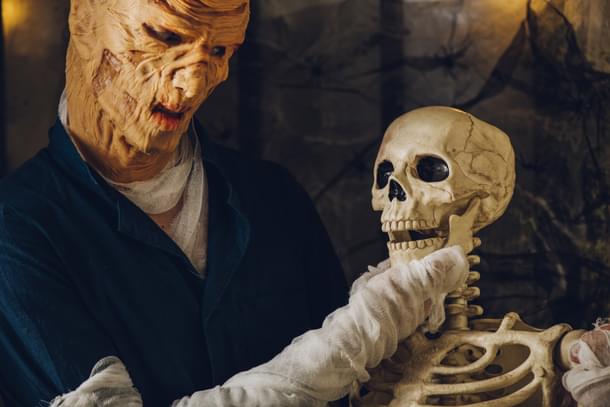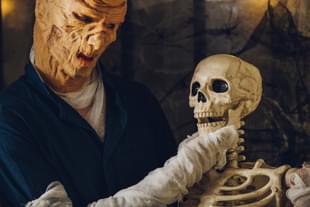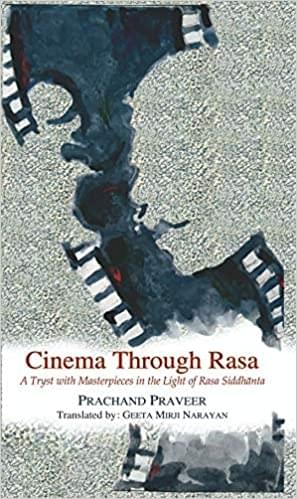Books
Book Excerpt: Of Rasa-Siddhanta, Vibhatsa Rasa And World Cinema
Prachand Praveer
Apr 05, 2021, 12:48 AM | Updated 12:48 AM IST
Save & read from anywhere!
Bookmark stories for easy access on any device or the Swarajya app.


Cinema Through Rasa: A Tryst with Masterpieces in the Light of Rasa Siddhanta. Prachand Praveer. D.K. Printworld, January 2021. 353 pages. Rs 700 (Paperback).
Leading contemporary Indian philosopher, Arindam Chakrabarti (2002), has mentioned Saadat Hasan Manto’s short story “Jelly” in his article on Vībhatsa Rasa. Let us study the story, “Jelly”:
At six o’clock one morning, near a petrol pump, a man who was selling ice on a hand-cart was stabbed with a knife and killed. His dead body lay on the street till seven o’clock and the ice on the cart was melting and dripping slowly onto his body. At quarter past seven, the police came and took away the dead body.
The cart and the ice were left behind. A horse cart drove past and the child sitting in it saw the shining clots of blood and his mouth watered. He pulled at the sleeve of his mother’s dress and pointing to the coagulated blood exclaimed, “Look mummy! Jelly”.
This scene shows the hideous picture of a dead body and a vague sort of repulsion toward it. The child referring to the blood clots as “jelly” shows a tendency towards cannibalism. According to Abhinavagupta, a hideous scene in a drama gives an extraordinary feeling of having relished a deep emotion wherein the immortality, ephemeral and dissipatory nature of the human being, is brought to the fore. According to Bharata Muni, the hideous or repulsive sentiment which is the sthāyī bhāva of Vībhatsa Rasa can be determined or is manifested when we see, hear and discuss, smell, taste, touch and speak about unacceptable, obnoxious, undesirable, malignant, virulent things (द्विवेदी 1992: 197).

According to Bharata Muni, Vībhatsa Rasa is of two types:
1. Distasteful (Udvegī) or manifestation of the rasa due to anxiety: the determinants for this are human body waste such as urine, faeces, vomit, worms from body and dribbling of saliva. These give rise to extreme hatred and disgust. The heart gets jolted when such repulsive things are seen.
2. Kṣobhaja Vībhatsa or the manifestation of the rasa due to the extreme agitation caused to the heart and mind: The determinants for this are seeing blood, intestines being pulled out or pictures of dead bodies, etc. (द्विवेदी 1992: 204).
It is quite natural to ask here whether Vībhatsa Rasa can actually be relished. Why did the ancient Indian aesthetic philosophers brand it as a different rasa? How can something which causes such intense disgust and repulsion qualify as a thing of beauty?
Through this theory, we are not studying the beauty of nature. We are not bothered about why the early morning sunrise feels so blissful? Why clouds and rivers enchant our heart thus? Many philosophers have wondered and thought about relishing human art rather than nature’s beauty. It is certainly a faulted human tendency, where many men and women, instead of helping an accident victim get medical help, stand around clicking pictures or making videos of suffering as though seeking aspects of beauty there too.
This is nothing but a faulty thought process or dereliction of duty.
A creator/poet/author has to try very hard to bring the intended feelings into the heart of the spectator/reader/listener. In some cases, the actor has to use the determinants of the Vībhatsa Rasa to convey his message. To show that war can be horrible, murder can be nefarious, madness can be disgusting, dramatists and filmmakers use Vībhatsa Rasa.
There is a world of difference between vībhatsa and common street fight. When the zenith of violence is able to show the effects of extreme disgust on the body, then it is truly repulsive.
Therefore, the rape scene in the B.R. Chopra directed Insaaf ka Tarazu (remake of American film Lipstick – 1976) and the repulsive antics of the hero in famous American director, Stanley Kubrick’s (1928-99) film, A Clockwork Orange (1971) do not come under the purview of disgust.
Many Hollywood films have shown repulsive scenes like killing and mutilating bodies to be as easy as eating ice-cream. Some famous examples of slasher movies are: Cannibal Holocaust (1980), The Thing (1982) and Saw (2004).
Similarly, much discussed film, The Exorcist (1973) shows a scene, wherein a small girl who is in the grip of an evil spirit, vomits a green liquid on the priest. This is to create a fear of spirits in the heart of the priest and is not a repulsive scene showing Vībhatsa Rasa. As we know, not a single drama or film can depict the emergence of one particular rasa, so we shall study films made by experts whose aim is not to shake or jolt the viewer and manifest the sentiment of repulsion, but much much more.
Unsavoury Disgust (Udvegī Vībhatsa)
While on the topic of distasteful and unpalatable films, it is imperative to discuss two outstanding, but difficult to understand, extremely gifted but impalpable film directors.
They have been keenly associated with literature and have made arduous films which have withstood the test of time. They are: Italian director, thinker, poet, journalist — Pier Paolo Pasolini (1922-75) and American director, David Lynch (b.1946).
Pier Paolo Pasolini was quite notorious for his revolutionary Marxist political views. His prominent films are: The Gospel According to St. Matthew (1964), Edipo Re (1967), Teorema (1968), Boccaccio’s Decameron (1971), Chaucer’s Canterbury Tales (1972), Il Fiore Delle Mille e Una Notte or The Flower of 1001 Nights (1974) and Salo o le 120 Giornate di Sodoma or The 120 Days of Sodom (1975).
If anyone watches Teorema or The 120 Days of Sodom before watching his films The Gospel According to St. Matthew and The Flower of 1001 Nights, they will for sure name Pasolini mad, neurotic or unrighteous.
The 120 Days of Sodom was based on Marquis de Sade’s infamous love novel. Just days before the release of this film, Pasolini was murdered quite brutally and repulsively by being crushed many times by his own car. The reason for the murder remains unknown. Marquis de Sade was a politician and spent the last 32 years of his life in a mental asylum. The word “sadism” (sadomasochism) is credited to him, it means the perverse sexual pleasure one gets when he/she sees someone afflicted by physical pain.
Pasolini’s last film astounds critics and viewers alike. Even today, many countries have banned The 120 Days of Sodom. Many critics have termed it as one of the most exceptional films of the world. Pasolini has based this film in twentieth-century fascist Italy, instead of eighteenth-century France. In the film, many youth are taken prisoners by powerful bureaucrats, defence authorities, judges and security officials of the priests and are kept in a large palace.
The youth are then subjected to distasteful sexual abuse by the powerful and reputed authorities with the help of some prostitutes. One disgusting scene shows that the imprisoned youth are being fed human excreta. To make this look real, Pasolini used black chocolate. To show the mental perverseness of the fascists, the tongues of the youth were cut and the eyes gauged out before they were hanged to death. This last scene of the film is the most repulsive. This is not a pornographic film because nobody can derive any kind of sexual pleasure from watching it.
Western film enthusiasts and critics have tried in vain to classify it as a “horror” film. This is an artistically important film which invokes pure disgust and repulsion in the viewer.
This film is also a mockery on fascist ideology and industrially made foodstuff like biscuits and noodles.
It is also a matter of concern that if such films are not seen, then how can its message reach the people. It is opportune to remember a quote by Franz Kafka in this context:
I think we ought to read only those kind of books that wound or stab us. If the book we’re reading doesn’t wake us up with a blow to the head, what are we reading for? So that it will make us happy, as you write? Good Lord, we would be happy precisely if we had no books, and the kind of books that make us happy are the kind we could write ourselves if we had to. But we need books that affect us like a disaster, that grieve us deeply, like the death of someone we loved more than ourselves, like being banished into forests far from everyone, like a suicide. A book must be the axe for the frozen sea within us. That is my belief.
This debatable film by Pasolini aims to do just that. David Lynch was greatly influenced by writer Franz Kafka, Russian writer Nikolai Gogol and the Indian Upaniṣads. He is well known for films like: Eraserhead (1977), The Elephant Man (1980), Blue Velvet (1986), Twin Peaks: Fire Walk with Me (1992), Lost Highway (1997), Mulholland Drive (2001) and Inland Empire (2006).
The repulsive sentiment has been very well captured in the film Eraserhead. In a scene of this futuristic film, it is shown that when the protagonist is eating chicken with his family, the cooked chicken gets up and starts walking and while walking, it starts bleeding. The hero’s girlfriend doesn’t want to take the responsibility of their newborn child and leaves them and goes away. The form and appearance of the newborn child is quite disgusting and distasteful; it has a snake-like face, his body swathed in bandages, a thin neck, death-like expression on the face, etc.
Psychologist Sigmund Freud’s theories are the mainstay of the story of this film. In the end, Henry, the protagonist, cuts off all the bandages from his child’s body. It is quite loathsome to find out that the internal organs of the child are actually held together by the bandages.
When the child starts screaming, the father stabs the child with the scissors in his hand and then instead of the expected red blood, a different fluid starts flowing out.
In much the same way in the film The Elephant Man, the hero is shown to have some physical deformity and the film Blue Velvet starts with the meeting of two cut-off ears, travelling into the secretive underworld.
These films try to awaken the repulsive feelings through the grotesque scenes. Instead of dialogues, David Lynch would rather make a film which has a bizarre storyline, handicapped bodies, etc.
Come and See (1985) is a Belarussian film which depicts the horrors of the Second World War. Through the life story of a youth, the hideous sentiment has been captured in the film. The story is about Nazi crimes against Jews. The young boy, who is ready to fight the Nazis, comes face to face with the murder of his mother and twin sisters. He also sees the dreadful scenes of death, when along with some Russian soldiers, he goes in search of food. People being killed, animals being slaughtered, Jews being burnt alive are some of the ghastly scenes the boy witnesses.
The film was a commercial success and has been enumerated as a great film world over. It has depicted the repulsive and disgusting scenes with great aplomb. The director, Elem Klinov (1933–2003), has not made any other film after this; he said that whatever he had to say and do, he did in this film.





